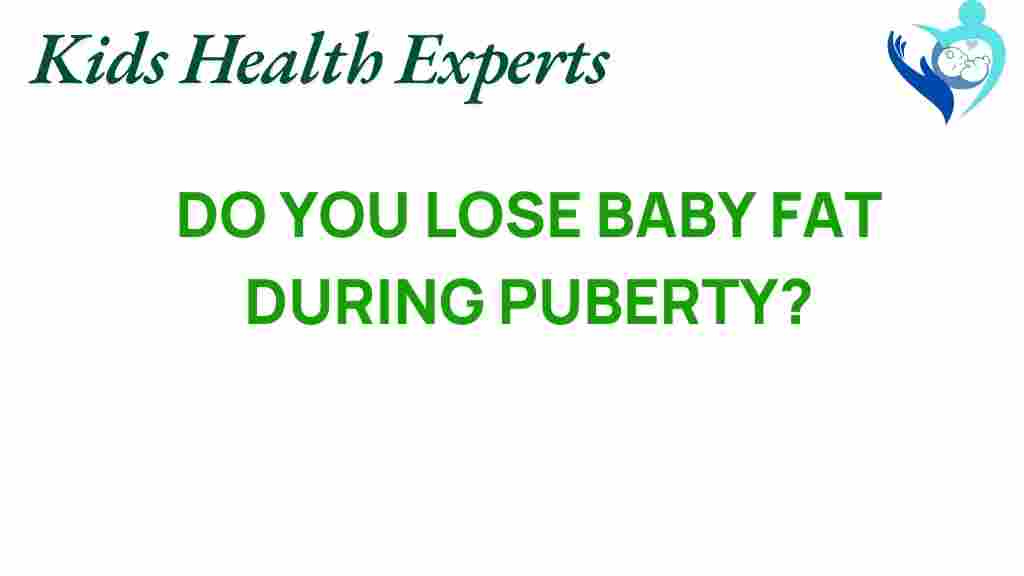Do You Really Lose Baby Fat During Puberty?
As children transition into their teenage years, many parents begin to wonder about the changes their kids are experiencing, especially regarding body composition. One common concern is whether children lose the so-called “baby fat” during puberty. This article explores the relationship between baby fat, puberty, and adolescent development, shedding light on health myths, body changes, and the science behind weight loss during this crucial period.
The Science of Baby Fat and Puberty
Baby fat, or the extra weight that infants and toddlers carry, is a normal part of early childhood development. However, as children grow and enter puberty, significant changes occur in their bodies. The following factors play a crucial role in this transition:
- Growth Spurts: During puberty, adolescents experience growth spurts that can lead to a change in body composition.
- Metabolism: Hormonal changes during puberty can affect metabolism, influencing how the body stores and burns fat.
- Diet and Lifestyle: Eating habits and physical activity levels are critical during this stage.
Understanding Body Changes During Puberty
The onset of puberty brings about a series of physical and hormonal changes. Here’s how these changes relate to body fat:
- Hormonal Changes: Hormones such as estrogen and testosterone play a significant role in redistributing body fat. For girls, estrogen leads to fat accumulation in the hips and thighs, while boys often see muscle development.
- Increased Muscle Mass: As adolescents grow, they may gain muscle mass, which can replace some of the baby fat, leading to a leaner appearance.
- Fat Redistribution: Baby fat does not simply disappear; it often redistributes to different parts of the body, which can alter one’s body shape.
Myths About Baby Fat and Weight Loss
There are many myths surrounding baby fat and weight loss during puberty. Let’s debunk some of the most common misconceptions:
- Myth 1: All baby fat is lost during puberty.
Truth: While many adolescents do lose some baby fat, it is not a universal experience. Genetics and lifestyle play significant roles. - Myth 2: Weight loss is always healthy during puberty.
Truth: Healthy weight management is essential, but extreme weight loss can be harmful during this critical growth phase. - Myth 3: Puberty guarantees a leaner body.
Truth: Each adolescent’s body reacts differently during puberty, and some may struggle with weight management.
Factors Influencing Weight Loss During Puberty
Several factors influence whether an adolescent loses baby fat during puberty:
1. Genetics
Genetic factors play a crucial role in determining body shape and fat distribution. If parents were heavier during their adolescent years, their children may have a similar experience.
2. Nutrition
A balanced diet is vital. Nutritional choices can affect weight loss and overall health. Eating plenty of fruits, vegetables, lean proteins, and whole grains supports healthy body changes.
3. Physical Activity
Regular exercise is essential for promoting a healthy metabolism and managing weight. Adolescents should engage in:
- Cardiovascular activities (running, swimming, cycling)
- Strength training (bodyweight exercises, weights)
- Sports and recreational activities
4. Mental Health
Mental and emotional well-being can significantly impact physical health. Stress and anxiety can lead to unhealthy eating habits and sedentary lifestyles. It’s important to foster a supportive environment.
Step-by-Step Process for Healthy Weight Management
Supporting adolescents during this time can help them manage their weight healthily. Here are steps to encourage a healthy lifestyle:
Step 1: Educate About Nutrition
Teach your adolescent about the importance of nutrition and making healthy food choices. Consider:
- Involving them in meal planning
- Encouraging cooking together
- Discussing the benefits of various food groups
Step 2: Promote Regular Exercise
Encourage your child to find an activity they enjoy. This could include:
- Joining a sports team
- Participating in dance or martial arts
- Taking family walks or bike rides
Step 3: Foster a Positive Body Image
Help your adolescent develop a healthy body image through open communication and support. Remind them that:
- Everyone’s body develops differently
- Health is more important than appearance
- Self-acceptance is crucial
Step 4: Monitor Health Myths
Educate them about health myths and the importance of understanding their bodies. Encourage them to consult reliable sources, such as health organizations.
Troubleshooting Tips for Parents
As a parent, you may encounter challenges while supporting your adolescent’s journey through puberty. Here are some troubleshooting tips:
1. Addressing Concerns About Weight
If your child expresses concerns about their weight, listen actively and provide reassurance. Encourage them to focus on health rather than numbers on a scale.
2. Managing Peer Pressure
Social dynamics can influence body image. Discuss the importance of individuality and remind them that they are not alone in their experiences.
3. Seeking Professional Guidance
If weight management becomes a significant concern, consider consulting a healthcare professional or nutritionist for personalized advice.
Conclusion
In conclusion, the journey through puberty is complex, and the question of whether adolescents lose baby fat is multifaceted. While many do experience shifts in body composition, factors such as genetics, diet, and physical activity play crucial roles. By fostering a healthy environment, educating about nutrition, and encouraging positive body image, parents can support their children through these changes. Remember, the goal is not just weight loss but overall health and well-being during this pivotal stage of adolescent development.
For more information on healthy adolescent development, explore our additional resources.
This article is in the category Growth and created by KidsHealthExperts Team
